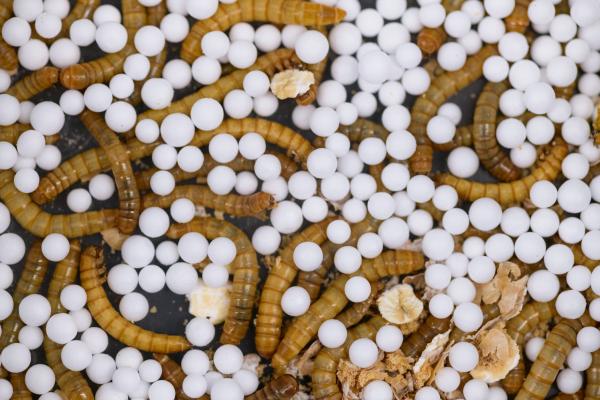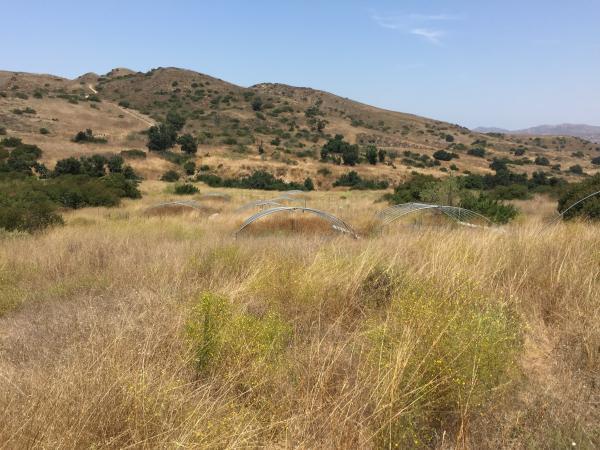Environmental Transformations and Interactions
EMSL User Science Showcased on National Podcasts
Topics included using yellow mealworms to combat plastic pollution and how microbiomes are impacted by wildfires and drought

Mark Blenner and Kevin Solomon spoke about their research using the microbiome of yellow mealworms to degrade plastic on the Tumble science podcast for kids and a television spot on PBS WHYY-TV. Around the same week, the Creative Process podcast highlighted Steven Allison and his research on environmental perturbations, like drought and wildfires, that impact microbial communities. Both research projects are collaborative studies utilizing EMSL’s instrumentation and expertise through the EMSL User Program.
Mealworms provide potential solution to plastic pollution

Blenner and Solomon are researchers at the University of Delaware who are studying how microbes inside the digestive tract of yellow mealworms can eat and break down single use plastics, like water bottles and wrapping paper. Their research is part of a three-year, $1.5 million Department of Energy project. Their research also is funded through the Fiscal Year 2022 Facilities Integrating Collaborations for User Science program call with EMSL and the Joint Genome Institute, which enables them to use instrumentation and resources at multiple user facilities through one proposal.
The Facilities Integrating Collaborations for User Science initiative research utilizes EMSL’s instrumentation to test out different metabolic pathways and determine how the plastics will be degraded.
“EMSL’s world-class proteomics capabilities are helping us identify the important enzymes involved in the critical steps that modify and initiate plastic depolymerization,” says Blenner.
The research goal is to gain understanding about how to develop a biotechnological process to degrade plastics and then to remove the need to use worms.
“Ultimately, we want to understand how these plastics are broken down,” says Solomon. “Plastics are source of carbon; our work will help us identify ways to harness it and upcycle or convert it into fuels and new medicines.”
Wildfires, drought, and microbial communities

Allison, a professor of ecology and evolutionary biology at the University of California, Irvine, spoke on the Creative Process podcast about how microbial communities change and evolve, particularly when disrupted by wildfires. This is the focus of his EMSL Large-Scale Research project, funded in fiscal year 2022. He’s leading this research with Bri Finley, also of University of California, Irvine, and Eoin Brodie of Lawrence Berkeley National Laboratory.
Their research, “Biogeochemical consequences of microbial trait tradeoffs under drought, wildfire, and nitrogen addition”, is focused on testing a new trait-based theory of microbial metabolism that connects fire, drought, and nitrogen impacts with biogeochemistry at genome through community scales. The research is part of projects looking at grasslands and shrubland ecosystems that are vulnerable to climate change. They are studying microbiome responses, including the effects of the Silverado fire from October 2020. The fire presented an opportunity to see how fire impacted the trajectory and evolution of microbiomes, says Allison.
The goal of their research is to provide the missing link between genomic data and microbial metabolism by combining sequencing techniques with high-resolution metabolomics on soil microbiomes. The big picture goal is to improve land management and reduce invasive species that contribute to wildfires.
“It’s really important to get a handle on what the microbes are doing because they’re such an important part of the ecosystem here,” notes Allison.
This project utilizes EMSL's resources in metabolomic profiling and analyses on leaf litter and surface soil samples from their field experiments using liquid chromatography mass spectrometry. EMSL’s proteomics, proton nuclear magnetic resonance, and X-ray computed tomography imaging capabilities will also be used characterize the soil environments that influence and are altered by microbial life history traits.
“We threw in everything but the kitchen sink and EMSL was willing to go for it,” says Allison.

